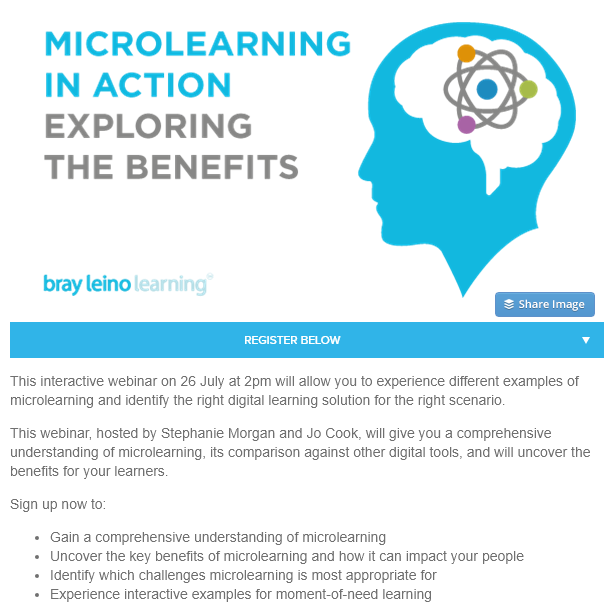On 26th July 2017 I’m delivering a webinar for Bray Leino Learning about microlearning!
Defining micro learning is a challenging concept, as different people think of different points. Shannon Tipton at Learning Rebels states that “microlearning is NOT a new term. It’s just new to the buzzword vernacular. Microlearning has been around for as long as people have been creating work aids to put toner in copy machines.”
In The LMS Features That Drive Employee Engagement (Software Advice, 14 Oct. 2014) Brian Westfall states that “58% of employees say they’d use their company’s learning software more if the content was broken up into shorter lessons.” This highlights the need to move away from scheduled menus of training sessions way off in the future, or the 1 hour click next poorly designed e-learning modules.
What is microlearning supposed to do?
An in-depth read is Micro Learning in the Workplace and How to Avoid Getting Fooled by Micro Instructionists that focuses on the work that Christian Glahn has done for a number of years as Professor for Blended Learning and the Director of the Blended Learning Centre at HTW Chur (University of Applied Sciences in Chur, Switzerland).
He states that “the goal of micro learning is to increase the time on learning and thus reducing the time needed for getting started with new more complex learning activities.”
Later in the article Professor Glahn goes on to say that “the key challenge for micro learning is not its potential but its operationalisation.” He expands on this by looking microlearning with regards to motivation and performance of the learner in a self-regulated environment as well as feedback and reflection.
Get to the point
This Training Zone article has tips for developing microlearning and highlights that “creating concise, focused content is harder than it sounds. Don’t fall into the trap of bloating content and taking it off focus.” This really highlights the point of the microlearning, that it’s one discrete item and not reliant on other materials for understanding.
The same article also encouraged us to “embed microlearning right into the applications and systems that your users use every day” rather than locking it away in a Learning Management System. This is great advice as it makes sure that the learning is in the workflow, where people need it.
Focus on the business need
This Knowzies article highlights the need to focus on “backward design” for microlearning, encouraging us to “identify the results desired and then design activities that will make desired results happen. Microlearning is outcome oriented and so following the backward design method or using approaches like action-mapping can easily assist in creating bite-sized modules that perfectly fit the purpose.” I’m glad to see other organisations also recommending the brilliant Action Mapping, and we should be doing this for all business challenges and learning interventions.
Some other nuggets
Grovo have developed a microlearning infographic you can download that has a lot of different information in it and highlights their approach about shrinking attention spans.
Lastly, this list of tools for learning when you have a short attention span has some great ideas for platforms and apps that may help with your own, or organisational learning.
Get involved
To discuss microlearning some more, come along to the free Bray Leino Learning webinar where I’m guest speaker on 26th July 2017.





Good stuff here Jo. Thanks for including me!
You do awesome work on this topic, so it was a no brainer!!